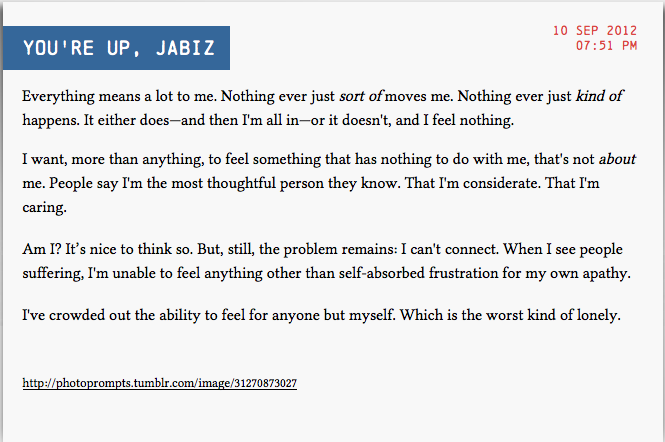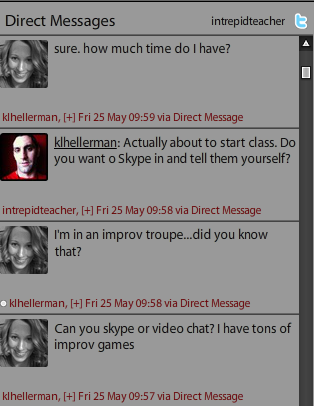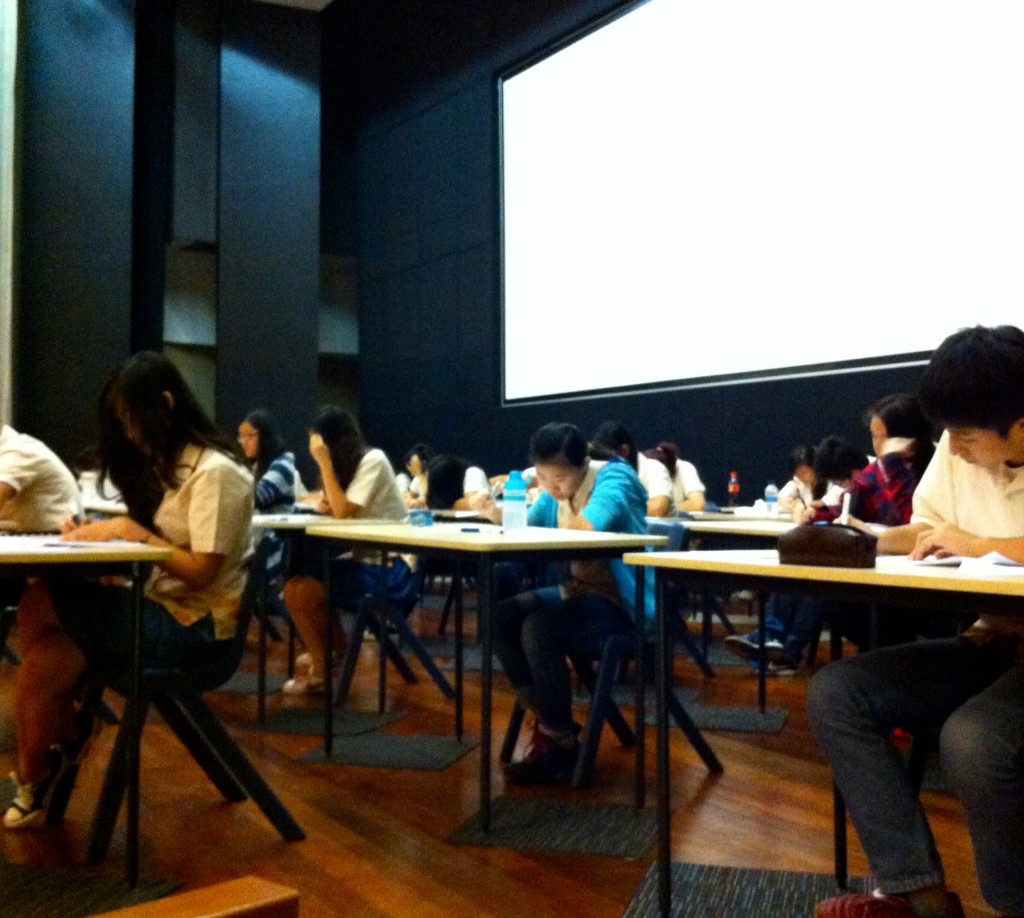Monday morning. Just got back from Yokohama/Tokyo and the Beyond Laptops Conference put on my Kim Cofino and the great people at the Yokohama International School. I have a million things to do, but I know that if I don’t pin this blog post, right now, onto some kind of solid wall in Cyber Space, it will will melt back into the ether with a million other thought and ideas. I need to strike the hammer while…..end cliche.
Conferences are exhilarating. Conferences are exhausting. They are empowering and frustrating. They can make you feel invincible, while somehow soul crushing at the same time. Before I continue, let me state that this post is not a criticism of the conference or Kim. She did an amazing job trying to satisfy a diverse group of people and our needs. She continually reached out for support and ideas before, during and after the conference and was more than flexible through the two day event. I had a great time and I learned so much. Thank you to everyone at YIS and all the participants. But you all now me well enough to know that I have opinions, and since I was not in the mood to elaborate in the feedback survey, I wanted to share my thoughts in the form of this post. I want to end on a positive note so I will start with the griping.
Not sure if you have heard, but technology is not about the tool. It’s not about devices or software. It’s not about numbers or proof. It’s not about, well apparently it’s not about a lot of things. We are all very good at pontificating what it is not about! Yet somehow, even though it is not about the tool, and even though we create smaller, more intensive conferences for people who realize that it is not about the tool, to discuss what it is about…we end up talking about the tool. We talk about BYOD, iPads verse laptops, or PD models based on– yes, you guessed it, how to use the tool. We are very good about talking about the tool, while saying that technology is not about the tool. Hence the frustration.
My second gripe was data driven. I am an English teacher. I hate numbers. I hate statistics. I hate quantifying the unquantifiable things in life, like poetry, like nature, like learning. After speaking with so many IT directors and school administrators, however, I can understand the need for numbers to justify budgets to school boards hungry for charts and graphs proving that the millions of dollars they spend on computers are amounting to something, but that is not where I want to spend my energy. My problem is that the only thing I hate more than numbers and charts are budgets and money. I got into teaching to inspire kids, to create authentic learning communities and to change the world. I want to go to conferences and talk about these types of things. I will leave the graphs and charts to other people.
These are my gripes and by no ways reflective of the mood or organization of the conference. Anyone who has ever organized any kind of PD, workshop, or conference know that you can NEVER please everyone. The small-group, hands-on, conversational tone of the conference was refreshing. It felt great to be able to express my viewpoint with so many of the decision makers from the major schools in Asia. It was valuable to be reminded that assessment of a program either for evaluation or justification has value. It was equally important for me to be the voice of a more qualitative look at the role of technology in our schools.
Throughout the conference, I was approached by several people who said they appreciated my frank, open and holistic look at educational technology. I want to spend the rest of this post trying to articulate just what that looks like. If technology is not about the tools, if it is not about data, then what is it about? How do we know it is “working?”

cc licensed ( BY NC SD ) flickr photo shared by superkimbo
We are immersed in a new culture. It is fluid, it is changing, it is evolving, it is breathing and dreaming and waiting for our input, and for the first time the we is all of us, the our is mine and yours. The involvement with, the creation of, the influence from, the participation in this culture is what concerns me. Acculturation is my focus. We are on a frontier. Pressed up against a fast moving edge to places we have never been before as a society. This understanding is what educational technology should be about: What does this culture look like? How does it affect each of us? How do we participate in it. Learn its language? Learn from it? Teach it? What happens to the me in we? What happens to you in the us? Where are we going? How did we get here? What does school look like in this new culture?
You want to see numbers right? How can we measure and quantify participation in a culture that is still forming? How do we know teachers and students are using technology to learn? Let’s start with the Horizon Report:
The NMC Horizon Project charts the landscape of emerging technologies for teaching, learning, research, creative inquiry, and information management. Launched in 2002, it epitomizes the mission of the NMC to help educators and thought leaders across the world build upon the innovation happening at their institutions by providing them with expert research and analysis.
Much of the work of the NMC Horizon Project takes place in a wiki where international experts across all different educational sectors openly exchange ideas and engage in insightful discourse. In this sense, the NMC Horizon Project represents a new ideal in education: free, open forums that facilitate global collaboration and encourage smarter discovery and dissemination of emerging learning approaches. All NMC Horizon Project reports and papers are published as open content, under a Creative Commons Attribution License, so permission is granted to replicate, copy, distribute, transmit, or adapt the content freely.
Not a bad place to start right? We spend so much time discussing the things that technology is not (a tool) that we never really talk about what it is. There is a nebulous list of 21st century skills that everyone seems to be referencing, but even that term is becoming laden with the heavy baggage of jargon. “Arghh, can we stop saying 21st century skills, it is 2012 already!” is the new “It’s not about the tool.” So what are we doing here? What are we talking about? Back to the Horizon Report. You can read more about the NMC or download the report on their website. I want to distill the key points from A Communique from the Horizon Report Retreat, January 2012. (One of many great resources from the Beyond Laptop reading list.) I have taken the already brief points and carved them down to a few free-standing words:
- Global
- Collaborative
- Diverse
- Mobile
- Access, Efficiency, and Scale
- Redefining Literacy
- Information Everywhere
- Openness
- Ownership and Privacy
- Change
This is what our new culture looks like. This is what we need to prepare ourselves, our students, our teachers and parents, for. The question stops being about iPads or PCs, and becomes– Is your school a global, collaborative, diverse, mobile environment with access to people and information? Are you helping to redefine literacy, showing your stakeholders how and when to access information that is everywhere? Are you showing them what to do with it, once they find it, in an open community of learners who understand the power of ownership and privacy? Most importantly is your institution not only ready for change but seeking it? Are you on the edge of your seat with your nose pressed up against the moving frontier or are you running to catch up, weighed down by stacks of charts and graphs justifying giving students and teachers access to a tool that is so unimportant that it doesn’t even warrant mention? Too simple? Perhaps, but if I could work at a school that understands these concepts and is working toward creating an ethos that values them, I would be a happy camper.
You want to know if your 1:1 program is working? Forget about in-house surveys and data, take a look at the ethos of your school, it’s online presence, its openness and connectivity? Take a look at the list above, how many of those concepts are you actively promoting and preparing for? Are they part of your vision statement? How much of your professional development is skills-based training and how much of it is cultural understanding? Are these ideas disrupting your school in a good way? Are you embracing them? Are you redesigning existing traditions like reports, timetables and content management to make room for them?
My suggestions for the next Beyond Laptops is that we focus on this new culture. Sorry, Kim. I know this is too little too late, but I had to go through the conference to realize want I needed from it. How do we create schools that are relevant in the age we live in and beyond? How do we teach the Web Kids? How are we all participating in this new culture?







